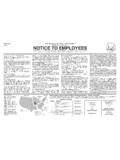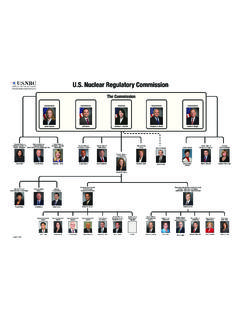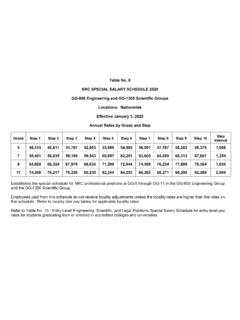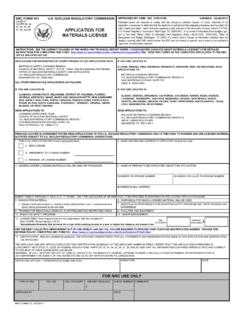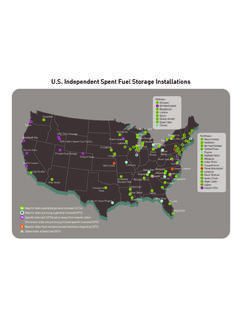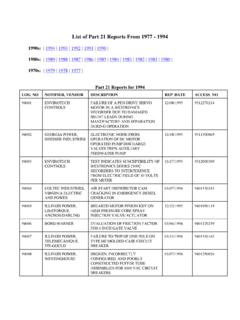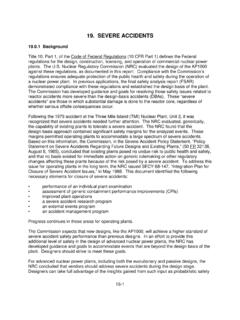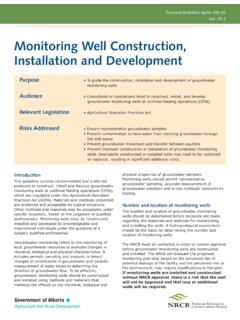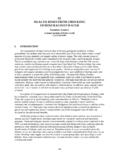Transcription of Chemical Resistance and Chemical Applications for CPVC ...
1 Chemical Resistance AND Chemical Applications FOR CPVC PIPE AND FITTINGS By Michelle Knight Chlorinated polyvinyl chloride (CPVC) has become an important engineering thermoplastic due to its relatively low cost, high heat deflection temperature, Chemical inertness and outstanding mechanical, dielectric, and flame and smoke properties. First commercialized in 1959 by Lubrizol Advanced Materials, Inc. (formerly BFGoodrich Performance Materials), it has proven over nearly five decades of use to be a viable piping alternative for a variety of industrial Applications in which a high use temperature and excellent Resistance to corrosive chemicals are required. The purpose of this document is to present a more detailed analysis of the Chemical Resistance capabilities of CPVC. It will provide specifiers and installers with information about those Applications in which CPVC performs the best, as well as those in which its use may be limited or not recommended at all.
2 Variables that can affect Chemical Resistance include Chemical concentration, temperature, pressure, external stress and final product quality. Since the number of possible use conditions is so large, the final decision regarding material suitability often must be based on in-service testing and direct communications with the piping manufacturer. This paper addresses capabilities and limitations that will provide general guidelines for an end-use application. CPVC An Overview At its most basic level, CPVC is a PVC homopolymer that has been subjected to a chlorination reaction. In PVC, a chlorine atom occupies 25 percent of the bonding sites on the backbone, while the remaining sites are filled by hydrogen. CPVC differs from PVC in that approximately 40 percent of the bonding sites on the backbone are filled with strategically placed chlorine atoms, while the remaining 60 percent of available sites are filled with hydrogen.
3 The chlorine atoms surrounding the carbon backbone of CPVC are large atoms which protect the chain from attack. Access to the CPVC carbon chain is restricted by the chlorine on the molecule. It is the additional chlorine that provides CPVC with its superior temperature and Chemical Resistance . Industry-Accepted Standards for Evaluating Chemical Resistance In addition to nearly 50 years of proven experience in the field, the Chemical Resistance capabilities of CPVC have been confirmed through work with numerous outside testing laboratories around the world. Equally important is the fact that Chemical Resistance has been determined, and confirmed, using two widely-accepted standards ISO 22088 and ASTM D543. Part of ISO 22088 specifies methods for the determination of Environmental Stress Cracking (ESC) of thermoplastics when subjected to a constant tensile load in the presence of Chemical agents.
4 Under this standard, materials are fully immersed in the Chemical agent. If the Chemical is highly viscous at the test temperature, the specimen is covered by a coating that is at least 2mm thick. During immersion, a constant tensile load is applied parallel to the longitudinal axis. In general, the maximum amount of stress to be applied is determined as being that which produces an elongation of 2 percent after one hour. The ISO test can be conducted using two different approaches. The first approach utilizes a series of tests that increase the amount of stress until the material sample ruptures. In the second approach, the goal is to identify the amount of time it takes to rupture the material sample when subjected to a single stress load. In either case, the test is run multiple times to ensure accurate results.
5 ASTM International has also developed standard practices for evaluating the Resistance of plastics to Chemical reagents. Standard D543 covers all plastic materials and provides specific guidelines as to how to administer the testing. This includes requirements on preparing the samples, conducting the actual tests, and reporting the results. Similar to the ISO testing standard, there are two approaches that can be taken under ASTM D543. In the Immersion Test, the sample is totally immersed for a minimum of seven days. At the completion of the test, the sample is re-weighed and re-measured and compared against its weight and measurements prior to immersion. The pipe surface is also observed for possible changes in texture, discoloration, swelling, clouding, tackiness, bubbling or cracking. In the Mechanical Test, the sample is also exposed to the Chemical reagent for a minimum time period, but during exposure, an external stress is applied (similar to ISO testing).
6 Even though both internationally accepted standards have proven reliable in their ability to determine a product s Chemical Resistance , many pipe manufacturers still recommend that a test be conducted to replicate a plant s process conditions. This will help to validate the expected reliability of the pipe in the presence of a specific Chemical . Suitable Chemical Applications One of the most attractive features of CPVC piping is its Resistance to corrosive chemicals the same chemicals that can degrade and reduce the service life of many metals, potentially causing expensive maintenance, disruption of operations and property-damaging leaks in these systems. Many of the same chemicals that cause the greatest damage to metal piping, including acids, caustics and salts, can be handled well by a properly installed CPVC piping system.
7 In addition, CPVC piping is not pH limited. It can accommodate wide pH swings in the fluids it transports. As a result of its superior corrosion Resistance , CPVC is proven acceptable for use with many different chemicals used in a wide array of industrial operations. Industries that have already successfully installed CPVC piping systems include metal finishing (chrome plating), chlor-alkali, wastewater treatment, pulp and paper, and food and beverage. In the metal finishing/plating industry, there are numerous reasons why CPVC has proven to be a viable alternative to metal primarily because of the strong acids used, including sulfuric acid for chrome and nickel stripping and the use of nickel sulfate and nickel chloride. In addition, the industry utilizes a many high pH caustics. These corrosive chemicals, especially when used in high-temperature environments, can quickly create major corrosion problems.
8 CPVC not only offers the necessary Chemical - and temperature- Resistance , but it also possesses the required impact and tensile strength. Similarly, the chlor-alkali industry frequently transports a number of highly corrosive chemicals, including sulfuric acid, sodium hydroxide (caustic soda), cell liquor (brine, sodium hydroxide), sodium chloride (brine), sodium hypochlorite, hydrochloric acid, and demineralized /deionized water . All of these have proven to be compatible with CPVC for use in steam condensate/evaporator systems, chlorine drying towers, and chlorine headers/manifolds, to name just a few Applications . In wastewater treatment Applications , harsh chemicals are a problem for many materials but can be handled easily and safely with CPVC piping. So whether a plant is using acids such as sulfuric, hydrochloric, nitric or phosphoric acid, or bases including caustic (NaOH), magnesium hydroxide and calcium hydroxide (lime), CPVC has proven to be compatible.
9 It can even handle those chemicals that are used in conjunction with today s treatment technologies, including ferric chloride, sodium hydroxide and sodium hypochlorite. In the pulp and paper industry, CPVC piping is ideal for use with pulp or bleaching operations, as well as for weak black liquor and green liquor in various storage and unit operations. Since most food and beverage plants require meticulous cleaning to meet strict health standards, process equipment is frequently cleaned using harsh chemicals or cleaning agents at high temperatures. These conditions can corrode most metals and make many plastics unsuitable, due to the extreme temperatures. But CPVC possesses both the corrosion and temperature Resistance needed to perform reliably and cost effectively. Refer to Appendix A for a full listing of chemicals that are both recommended and not recommended for use with CPVC piping.
10 Again, remember that Chemical compatibility can be ultimately affected by many factors, including temperature, pressure and design of the system. Some piping manufacturers offer technical assistance and will actually test specific Chemical formulations to determine Chemical compatibility. It is always recommended to work with the specific pipe and fitting manufacturer in determining material suitability. It should further be noted that CPVC products are made with base resins having different molecular weights and chlorine content, as well as different compound additives. Therefore, it is always recommended to check with a specific pipe and fitting manufacturer before confirming actual Chemical Resistance capabilities and compatibility. Caution Areas and Indications of Chemical Compatibility Problems Chemical Resistance issues can show up in a number of ways, with the most common problems being softening, degradation and cracking.

